Jupiter
| 10th May 2008
Schmidt Newtonian x5 Powermate
Captured using a Mintron 62V1P-Ex color
video camera fed to a Panasonic Mini-DV camcorder (tape). Then captured later to PC
and processed in Registax.
|
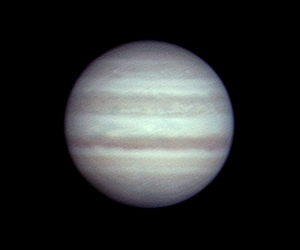
|
| 10th May 2008 Schmidt Newtonian x5 Powermate x2 Barlow
Captured using a Mintron 62V1P-Ex color
video camera fed to a Panasonic Mini-DV camcorder (tape). Then captured later to PC
and processed in Registax. |
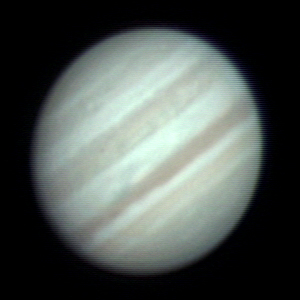
|
| 10th May 2008
Schmidt Newtonian x5 Powermate
Captured using a Mintron 62V1P-Ex color
video camera fed to a Panasonic Mini-DV camcorder (tape). Then captured later to PC
and processed in Registax. Converted to grayscale which seemed to reveal more
detail.
|
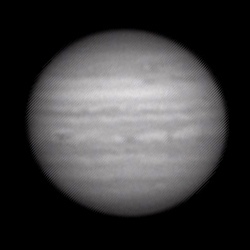
|
| 10th May 2008 Schmidt Newtonian x5 Powermate
Captured using a Mintron 62V1P-Ex color
video camera fed to a Panasonic Mini-DV camcorder (tape). Then captured later to PC
and processed in Registax (including digital enlargement).
|
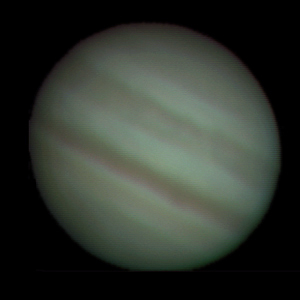
|
|
|
The following images are not for the faint hearted.
These newbie images were collected when I was first starting out so cut
me some slack.
| Latest Image: Captured 12Jun06 1300 hrs UTC Canberra
Australia. Very pleased with the detail in this one. The fine detailed
features of Jupiter's atmosphere that you see in the image at right match exactly the
structures visible in larger more detailed NASA photos. I think the color balance
could be improved somewhat, for example some areas should be blue and the Great Red Spot
(visible top left corner of the planet) should be pinkish (not red). This is a stack of
400 images captured with the Mintron MTV 62V1P-Ex video camera at prime focus (Televue x4
Powermate plus a 2x Orion Short-Plus barlow). Total focal length around 6.4 metres
(f/32). Captured to video by Astrovideo and then processed in Registax. Gain
was Maximum, shutter 1/100sec, Color balance was "Red" (3200K?). Registax
wavelet pattern was 128 in the centre and 1's all round. |
Latest Image
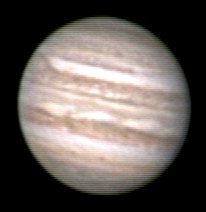
|
| Good Color: Captured during 12Jun06
session. This one has good colors (see the blue tint to the festoons for example)
but the image overall doesn't have crisp detail.
This may be because for this image the gain was set to 3/4 of maximum. My current
thinking is that I must set gain to maximum in order to capture the best detail.
Also in this shot the brightness was high enough to allow Ganymede (moon) to be visible. |
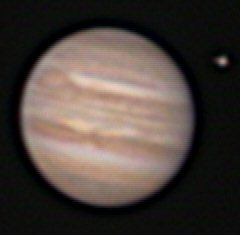
|
Two Moons: This shot has two of Jupiters moons in shot. Io is on
the left and is about to go behind Jupiter and Ganymede is on the right having just
emerged from behind Jupiter. In order to make both moons visible the brightness has
to be cranked up which has the effect of blowing out Jupiter to near-white. |
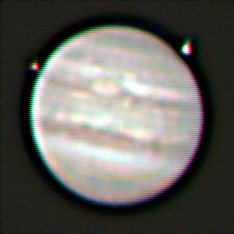
|
First Image: Captured 1600 hrs UTC 26Jan06 Canberra Australia. This
was my first Jupiter image with the LXD-75 SN-8 telescope. Note the distortion in
the planet probably due to miscollimation, or else the barlow lens (or indeed the camera)
was not square in the focuser or a combination.The data was acquired as usual from
color video camera (Mintron MTV-62V1P-Ex) to a Mini-DV tape camcorder and then fed, later,
via firewire into my PC. Captured to PC (.AVI file) using Astrovideo
then aligned in Registax. |
My First Color Image of Jupiter
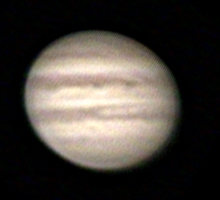
|
Other Details:
The data for my planetary imaging is usually captured at prime focus of a Meade
SN-8" LXD-75 using Mintron 62V1P-Ex color
video camera. An Orion Shorty (x2) Barlow is stacked into a Televue Powermate x4.
The effective focal ratio of about f/32. Shutter is 1/50 second, AGC gain maximum, no
filters.
Focus is achieved visually by using a Hartmann mask and/or watching the focus
adjustments on my TV.
Jupiter responds best when it's more than 45 degrees altitude above the horizon.
Seeing very dramatically influences the quality of the result. In bad seeing you
might as well pack up. Note that "seeing" is not always a problem created
in the upper atmosphere. It could be the hot bricks or the footpath near (or under)
you. It could be that you haven't allowed enough time for your telescope to cool
down, or that your telescope can't cool down to match atmospheric temperature because the
atmospheric temperature is falling too quickly. I hope in the future to invest in a
fan to blow air into the back of my mirror to assist with this problem.
Other Jupiter Images:
Jupiter 12Jun06
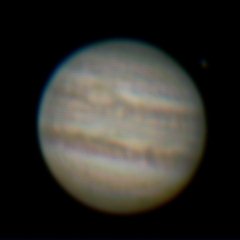
|
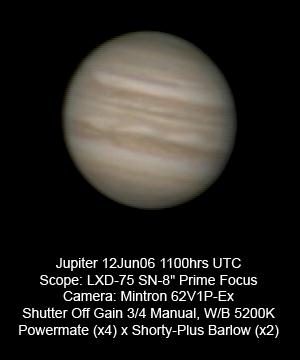 |
Jupiter 12Jun06
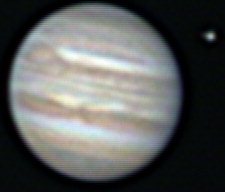 |
| |
|
|
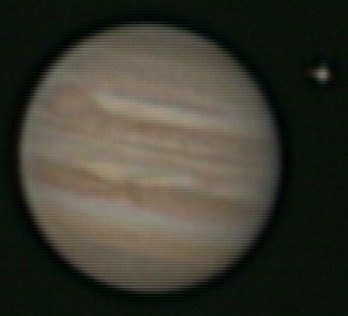
Jupiter and Ganymede 12th June 2006 (Drizzled)
The last image of the page is enlarged through a technique invented for
the Hubble telescope called Drizzling. Drizzling interpolates the space between
pixels to achieve an apparent increase in resolution. It is much more effective than
just doubling the size of an image. Drizzling is a feature available in the Registax
software.
See Other Planets
Back to Home
|

